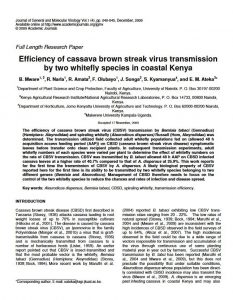The efficiency of Cassava brown streak virus (CBSV) transmission by Bemisia tabaci Gennadius (Hemiptera: Aleyrodidae) and spiralling whitefly Aleurodicus dispersus Russell (Homoptera: Aleyrodidae) was determined. The transmission utilised field-collected adult whitefly populations (allowed a 48-hour acquisition access feeding period [AAP]) fed on cassava brown streak disease (CBSD) symptomatic leaves before transfer onto clean recipient plants. In subsequent transmission experiments, adult whitefly numbers of each species were varied per plant to determine the effect of whitefly numbers on the rate of CBSV transmission. CBSV was transmitted by B. tabaci allowed a 48-hour AAP on CBSD-infected cassava leaves at a higher rate of 40.7% compared to that of A. dispersus at 25.9%. This work reports for the first time the transmission of CBSV by A. dispersus. A likely biological property of CBSV reported here for the first time is its ability to be transmitted by two whitefly species belonging to two different genera (Bemisia and Aleurodicus). Management of CBSD therefore needs to focus on the control of the two whitefly species to reduce the chances and rates of infection and disease spread.
Region: Kenya
Date published:
2009
Published by:
Journal of General and Molecular Virology
Type of resource:
Journal article
Resource topic:
Cassava
Project/Programme: Not specific
Pest/Disease: Cassava brown streak virus, Whitefly
Pages:
6
File type:
External link (187 KB)




